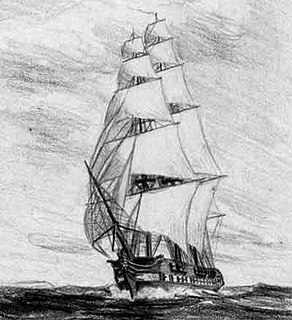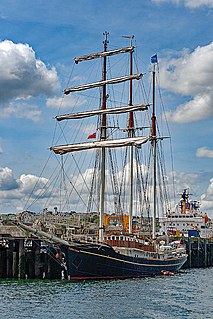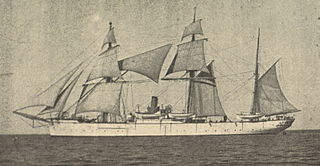
Joseph Conrad is an iron-hulled sailing ship, originally launched as Georg Stage in 1882 and used to train sailors in Denmark. After sailing around the world as a private yacht in 1934 she served as a training ship in the United States, and is now a museum ship at Mystic Seaport in Connecticut.

Martin Hans Christian Knudsen was a Danish physicist who taught and conducted research at the Technical University of Denmark.

Cape Horn is the southernmost headland of the Tierra del Fuego archipelago of southern Chile, and is located on the small Hornos Island. Although not the most southerly point of South America, Cape Horn marks the northern boundary of the Drake Passage and marks where the Atlantic and Pacific Oceans meet.

The Galathea expeditions comprise a series of three Danish ship-based scientific research expeditions in the 19th, 20th and 21st centuries, carried out with material assistance from the Royal Danish Navy and, with regard to the second and third expeditions, under the auspices of the Danish Expedition Foundation. All three expeditions circumnavigated the world from west to east and followed similar routes.

The Copenhagen Zoological Museum is a part of the Natural History Museum of Denmark, which is affiliated with the University of Copenhagen.
The Galathea Depth is the portion of the 10,540-metre-deep (34,580 ft) Philippine Trench exceeding 6,000-metre (20,000 ft) depths in the south-western Pacific Ocean. Originally discovered by the German ship Planet in 1912, it was first explored in detail by the Danish ship Galathea in 1951 on the Galathea 2 expedition, from which the name is taken. Biological samples collected during the Danish expedition demonstrated a wide variety of fish, amphipods, and bacteria surviving at depths seldom seen before.

The Tall Ships' Races are races for sail training "tall ships". The races are designed to encourage international friendship and training for young people in the art of sailing. The races are held annually in European waters and consists of two racing legs of several hundred nautical miles, and a "cruise in company" between the legs. Over one half (fifty-percent) of the crew of each ship participating in the races must consist of young people.

The era of European and American voyages of scientific exploration followed the Age of Discovery and were inspired by a new confidence in science and reason that arose in the Age of Enlightenment. Maritime expeditions in the Age of Discovery were a means of expanding colonial empires, establishing new trade routes and extending diplomatic and trade relations to new territories, but with the Enlightenment scientific curiosity became a new motive for exploration to add to the commercial and political ambitions of the past. See also List of Arctic expeditions and List of Antarctic expeditions.
J. Lauritzen(JL) is a Danish shipping company with worldwide operations headquartered in Hellerup, Denmark. JL is a private company wholly owned by the Lauritzen Foundation, a Danish commercial foundation that is also the main shareholder of DFDS, one of Europe's largest ferry shipping and logistics company.

The Shenandoah is a three-masted schooner with a steel hull, built in New York in 1902. She is a private yacht.
Inger Klein Thorhauge is a Faroese cruise ship captain for Cunard Lines. When she was named Captain of MS Queen Victoria in 2010, she became the first female Captain in the history of the cruise line. She has since become Captain of MS Queen Elizabeth.

HDMS Bellona was a frigate of the Royal Danish Navy, which she served from 1835 to 1862.

Dana was the primary Danish research vessel for almost 40 years. It was built in 1937 and served research purposes until 1980. On the first cruise into the North Atlantic in 1938 it was discovered that the ship was unsuited for its purpose, as it was not sufficiently stable to allow scientific work. It was returned to the shipyard and extended by 8 metres (26 ft) in 1939. During the Second World War (1940-1945) the ship was kept and maintained in Copenhagen harbour, but with vital engine parts removed and thus never seized by the German occupation force.

Thor was a Danish research vessel from 1903 to 1927. It was built in Newcastle in 1899 as a steam trawler. Thor conducted hydrographical and oceanographical research in the North Atlantic and the Mediterranean and helped locate the spawning grounds of the Icelandic cod. Most importantly, Thor conducted two expeditions to the Mediterranean Sea in 1908-1910 with Johannes Schmidt as cruise leader. The aim of the expeditions, funded by the Carlsberg Foundation, was to locate the spawning grounds of the European eel. Contrary to their expectations the expeditions found that fewer eel larvae (leptocephals) were found the deeper they went into the Mediterranean, but they also grew larger. The logical conclusion was that the spawning grounds were not in the Mediterranean, but in the Atlantic Ocean. In a broader perspective the largest result from the two expeditions was the very large contribution to the general understanding of the oceanography and pelagic fauna of the Mediterranean.

HDMS Galathea was a three-masted corvette, build for the Danish Navy. It had a single, closed cannon deck and was equipped with 26 18-pound cannons, two of which were on the forecastle and two on the quarterdeck. It was a full-rigged ship, with royals and skysails on all three masts. However, the ship keeled over too much under all sails and the masts were shortened and sails reduced in 1844. The ship carried one longboat and four smaller boats.

HDMS Grønland (Greenland) was a ship of the line of the Dano-Norwegian Navy, built in 1756 and decommissioned in 1791. Grønland spent considerable time in the Mediterranean Sea, where she protected Danish merchant convoys. Grønland took part in the bombardment of Algiers in 1770 but otherwise did not see any action in battle. It is noted in the Danish Admiralty's papers that she was an unusually seaworthy ship.

HDMS Ingolf was a Danish schooner-rigged steam gunboat build in iron and launched in 1876. Ingolf marks a transition between the traditional gunships with muzzle-loading cannons placed along the sides of the ship and modern breechloading and turning guns placed in the centerline of the ship. The guns on Ingolf were breechloading guns from Krupp in Germany. The steam engine was British and could deliver 650 HP. The propeller could be hoisted up into a well on the underside of the ship, so as not to slow down the ship when she went for sails. Ingolf undertook a large number of voyages, often in the North Atlantic in summer and the Danish West Indies in winter. From 1897 Ingolf also served as training ship for non-commissioned officers and cadets. During World War I Ingolf was part of the Danish alerted fleet. The last voyage as a training ship was in 1922 and went to the Mediterranean. Decommissioned in 1926 and sold for scrap.
S/S Godthaab was built in 1897–98 at C. Christensen ship yard, Sandefjord, Norway, for the Royal Greenland Trading Department and was the company's first steam ship. The main task for the ship was sailing on the east Greenland settlement Angmassalik and was built for that purpose with a 240 HP engine and reinforced hull. Godthaab served as base for several expeditions in the Arctic, most notably the expeditions by Lauge Koch between 1926 and 1934. Godthaab sailed for the Royal Greenland Trading Department until it was sold in 1953 to the Faroe Islands. Here it was refitted for herring fishery and renamed Hvitabjørn. It was sunk in 1984 after being badly damaged by fire.



















